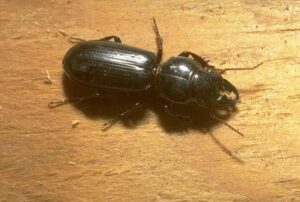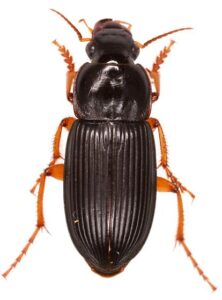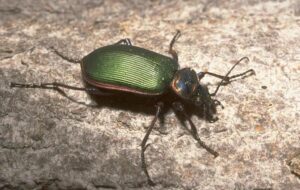Ground Beetles: The Predators in Your Garden
by Kathleen Curthoys, Fairfax Master Gardener
They march into your garden, looking like they’re wearing armor. They dart out at night and prowl for prey they can sink their mandibles into. Good thing they’re your friends.

Ground beetle
Ground beetles (family Carabidae) may look tough but they do a great favor for their friends, the gardeners. These fierce predators are on the hunt nightly for the insects that feed on your plants. These beneficial insects eat caterpillars, aphids, grubs, fly maggots, root maggots, cutworms, snails, spiders, slugs, mites, other beetles and more.
And they’re hungry. Both larvae and adults are predaceous and capable of consuming their body weight in food each day. Larvae have been known to kill more insects in a day than they eat. Most ground beetle species are primarily carnivorous, speeding around the garden after dark. Some are generalist or opportunistic eaters, meaning they feed on many sorts of things they come across, such as pollen.

Harpalus pensylvanicus with its distinctive orange legs
Ground beetles, also known as carabid beetles, number in the tens of thousands of species globally. They are common throughout Virginia. They live in nearly every kind of habitat, such as forests, fields, farms and buildings. They shelter in debris, logs and cracks in the soil, concealed during the day in quiet, damp places such as mulch, woodpiles and vegetation.
Most species live and forage at ground level. Larvae emerge from soil tunnels to grab their dinner or go cruising above ground. A few species such as the fiery hunter (Calosoma sp.) will climb trees and prey on caterpillars.
A few species of ground beetle feed on plants, including weed seeds and weed seedlings. Ground beetles known as granivores eat mainly seeds as well as insects. Two common granivores in North America are Harpalus pensylvanicus, active in summer and fall, and Anisodactylus sanctaecrucis, seen often in spring and summer. They can be good controllers of weeds such as lambsquarters, pigweed, foxtail, crabgrass and others.
Attracting these good guys to your garden
You can put the welcome sign out by keeping a habitat for them. When tilling the garden, leave a protected area such a bed of pollinator plants, perennial herbs or mulch that would attract beneficial insects. These areas of organic matter will give beetles the food sources, shelter and moisture they need. Keep these areas free of insecticides.
Grow a diverse ecosystem with abundant flowering plants, shrubs and trees to encourage beneficial insects to visit and stay a while as a biological control for insect pests. Keeping your plants healthy will also help keep them resistant to pests.
Planting “beetle banks,” or rows of bunch-type grasses between crop rows, can provide refuge and shelter for overwintering beetles, studies show. Putting down hardwood mulch over planting beds can make beetles at home by giving them nooks and crannies to inhabit. Compost and animal manure are more beneficial to resident beetles than chemical fertilizer, researchers have found.
Giving ground beetles a healthy garden environment will reap benefits and possibly save you money. Farmers have said the cost of building beetle banks is balanced by spending less on pesticides.
Identifying a ground beetle
With so many species, there is wondrous variety. Many ground beetles are black or brown, and some brightly colored. They may look iridescent, metallic or shiny, like Darth Vader’s helmet. One colorful and common ground beetle you may see in spring is the Six-Spotted Tiger Beetle, Cicindela sexguttata, sporting vivid green.

Green ground beetle
But they have some things in common. Adults tend to have large eyes, strong jaws, chewing mouthparts and prominent antennae. The head may be smaller than the thorax, or their middle section. Fast runners and good climbers, the adults have a hardened exoskeleton and relatively long legs. Many have two pairs of wings and some may fly.
The adult beetles as a group vary greatly in size, from 1/8 inch to 1 1/4 inch (2 – 70 mm). Ground beetles have a complete life cycle, with egg, larval, pupal and adult stages. They lay their eggs in damp organic material, inside crevices, under debris or in the top layer of moist soil.
The larvae may be cream colored or brown and look like caterpillars. They have large jaws and three pairs of legs on the thorax. Both immature and adult beetles have chewing mouth parts.
The adults may overwinter and live up to four years.
Ground beetles typically can only be called a pest when they get into a house or other building. They can enter through small openings or cracks. But indoors, they do not reproduce and aren’t known to cause damage to buildings, food or clothes. If you find a beetle indoors, it can be picked up and returned to the outdoors, though use caution because larger beetles can pinch or bite if not carefully handled.
Try sealing up small openings and clearing debris from around the house to help keep ground beetles outside. Keep them doing their kind of garden patrols so you don’t have to.
Resources
• Ground Beetles, Theresa A. Dellinger and Eric Day, Department of Entomology, Virginia Cooperative
Extension
• Ground Beetles are Beneficial in Your Garden, Ashley Bodkins, Garrett County Maryland Master
Gardeners, and Christa K. Carignan, University of Maryland Extension
• Predatory Beetles, Mike Raupp, Jon Traunfeld and Chris Sargent, University of Maryland Extension
• Ground Beetles Provide Insect and Weed Biological Control, Paula Shrewsbury, TPM/IPM Weekly
Report, Oct 2, 2020, University of Maryland Extension
• Habitat Planning for Beneficial Insects, The Xerces Society for Invertebrate Conservation via
University of Minnesota
• Good Bugs, Bad Bugs, Cleve Campbell, Piedmont Master Gardeners